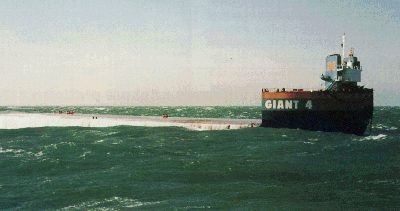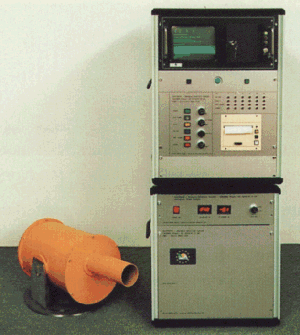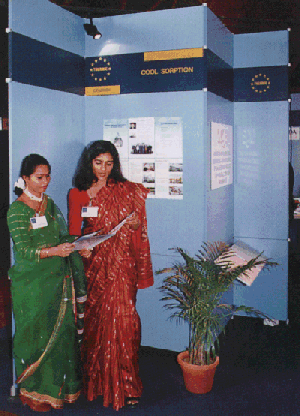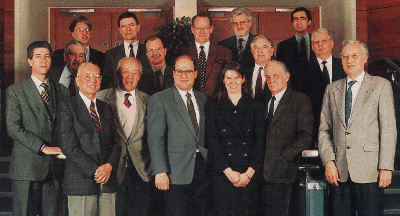

Issue 19 April 1996
European offshore technologies focus on safety
During the last decade, innovative technologies
have played an increasingly important role in improving safety
levels in the offshore oil and gas industries. Everything from
fire and blast technologies to systems for preventing ship collisions
have all helped to make the hydrocarbons industry a safer environment.
The European Commissionís THERMIE
Programme has been at the forefront in encouraging the development
of safety technologies and this issue of O>N describes four
projects with safety implications. This includes an offshore
traffic prediction system developed in the Netherlands, a methane
detection system for rigs developed in Italy, a technique for
assessing defects on offshore structures developed in the UK,
and an advanced risk management system developed in France.
Safety, however, is only one of the many
technical areas which THERMIE is concerned with in the hydrocarbons
sector. Examples of other innovative European oil and gas technologies
will be on show at the European Unionís booth (No. 6277)
at the Offshore Technology Conference in Houston (6-9 May 1996).
Improving traffic and offshore platform safety
 During the last two decades the growth in
offshore oil and gas production has resulted in many platforms
being sited in the North Sea and Mediterranean, traditionally
busy shipping routes. These platforms are increasingly threatened
by drifters, i.e. vessels without propulsion or steering which
are subjected to wind, waves and current.
During the last two decades the growth in
offshore oil and gas production has resulted in many platforms
being sited in the North Sea and Mediterranean, traditionally
busy shipping routes. These platforms are increasingly threatened
by drifters, i.e. vessels without propulsion or steering which
are subjected to wind, waves and current.
TOPSS (Traffic and Offshore Platform Safety
System), developed by MARIN in The Netherlands with support from
the ECís THERMIE Programme, aims to provide an operational
system for the prediction of the track of an arbitrary vessel
drifting in arbitrary weather conditions. The system contains
extensive data on tidal currents, water depths, coastlines and
platform locations. Basic data on wind wave and current loading
is available in the system for various ship types.The drifting
track of the vessel can be simulated with a minimum of input information
such as the length of the drifter, it's position and the wind
speed and direction. The system is also able to evaluate possible
interventions such as the use of rudders, bow thrusters and tugs.
The simulation model is incorporated in
a user friendly operational system running on a graphical workstation
under Unix. The X-windows based system is menu driven and features
presentation of all relevant data together with a 2-D graphical
area manager showing the drifting track in the area, coast lines,
shipping lanes and platform locations.
The model has been verified with results
from tests conducted at 1:50 scale under laboratory conditions
followed by extensive full scale demonstration trials in the North
Sea with three vessels under various weather conditions. TOPSS-simulated
tracks show a good agreement with the measured tracks for the
drifting vessels in the sea trials. Both the course over ground
and the speed over ground proved to be within acceptable accuracy
for practical applications.
TOPSS will contribute to safe shipping
and offshore production in European coastal waters; avoiding ship-platform
collisions and tanker groundings significantly contributes to
conservation of the seas and coastal environments. TOPPS can
also be applied to search and rescue (SAR) operations for small
objects such as life rafts and containers with dangerous cargo.
TOPPS has been installed by the Dutch Coast Guard and is now
being considered by the UK Coast Guard.
Assessing defects on offshore structures
Assuring the structural integrity of an
offshore platform requires the compilation and analysis of enormous
volumes of data. This includes inspection, maintenance and repair
reports and structural analysis results. Until now much of this
assessment work has been done by hand which is both costly and
labour intensive. To rationalise this process BOMEL has developed
a new package called AMaDeOS (Assessment and Management of Defects
on Offshore Structures), which combines a comprehensive structural
and inspection database with an expert system capable of monitoring
and assessing the integrity of a platform throughout its operational
life.
AMaDeOS is a state-of-the-art PC based
object oriented program running under Microsoft Windows. Structural
and inspection data is centrally located and accessed via a Graphical
User Interface (GUI) which is a powerful visual tool for immediate
retrieval and display of the structural model, structural analysis,
results, inspection data, drawings and photographs.
The structural data is stored in a neutral
file system which can be interfaced to most commercially available
analysis software. The inspection data including photographs and
drawings is entered using the Inspection Data Entry System, designed
for both onshore and offshore applications. The knowledge-based
system which has direct access to this data has been designed
to identify anomalies and trends in the data and provide expert
advice including assessing strength, fatigue, fracture and reliability
analysis software modules. This advice, combined with a structural
indexing system, will allow optimised inspection plan schedules
to be developed.
The development of AMaDeOS was supported
by the THERMIE Programme and Amoco (UK) who will use the system
to monitor a number of their North Sea platforms.
Methane detection improves rig system
 A seven month offshore test has successfully
demonstrated that fibre optics laser based gas detection technology
is mature enough to be proposed for field use. The tested instrumentation
is the prototype of GASTRACK, a methane detection system, designed
and constructed by Tecsa spa (Italy) and Vuman Ltd (UK) in co-operation
with Snamprogetti Ltd (UK).
A seven month offshore test has successfully
demonstrated that fibre optics laser based gas detection technology
is mature enough to be proposed for field use. The tested instrumentation
is the prototype of GASTRACK, a methane detection system, designed
and constructed by Tecsa spa (Italy) and Vuman Ltd (UK) in co-operation
with Snamprogetti Ltd (UK).
The system was installed at an offshore
gas rig owned and operated by Agip spa (Italy) in the Adriatic
Sea close to Ravenna. The main advantages of the instrument include:
- the absence of any electrical part in
the field;
- high sensitivity and very good stability;
- the system does not need any field re-calibration.
GASTRACK consists of a number of open path
gas detection cells (typically 5-10) connected by silica optical
fibres to a central unit hosting the spectrometer and the electronics.
The principle of operation is the measurement
of the high-resolution infrared absorption spectra of a methane
band close to 1.3 m. The infrared radiation (less than 1 mW) is
emitted by a Fabry-Perot laser diode and directly coupled with
an optical isolator and a monomode silica fibre. An opto-mechanical
multiplexer allows the fibres leading to the cells to be connected
sequentially to the source. The same fibre brings the IR radiation
back to the main unit where it is detected by a photodiode. A
sealed gas cell filled with methane is provided in the main unit
to check the system operation and its calibration.
The instrument is controlled by a 80486
based industrial PC which also performs extensive self checking
and supports a user friendly interface. GASTRACK was designed
to fulfil the requirements of all the applicable EN regulations.
The demonstration of GASTRACK has shown
the system to be technically excellent. However, the project
cost per cell is approximately double that of the best open path
gas detectors available on the market. As a result, the next
development will be to extend the measurement to CO and
H2S.
TRI srl, a daughter company of Tecsa, is planning to complete
the development and manufacture the resulting product.
Advanced risk management
ARMS (Advanced Risk Management System) is a decision support system
which helps operational personnel manage hazardous situations
onboard offshore production platforms. The system, developed by
Bureau Veritas (France), Technicatome (France), TNO (The Netherlands),
D'Appolonia (Italia) with support from the ECís THERMIE
Programme, provides operators with an estimate of the risk level
at a given time, and expected changes in the risk level within
a specified time window. It also provides guidance for rational
risk management decisions. The estimation of the risk level is
based on various factors including:
- the current status of maintenance activities;
- the anticipated variations of the most critical process parameters;
- the states of safety systems;
- organisational factors such as personnel qualifications.
Offshore platforms are dynamic and changing
systems therefore the risk level that characterises the hazard
is updated at each time interval. Depending on the time horizon
and the time available for a primary decision, ARMS allows a choice
to be made from various alternatives (e.g. a sequence of tests
to improve the primary decision). The architecture of ARMS relies
on four modules:
- Work Permit System Model
- Platform Model
- Risk Assessment
- Decision analysis.
The Work Permit System assists platform
operators in managing activities on board and the risk associated
with them, taking into account safety concerns, compatibility
between concurrent tasks and organisational factors. The Platform
Model consists of two sub-models: a topological one characterising,
for example, the compactness of the deck, and a functional one
showing the different process functions.
The Risk Assessment module evaluates and
updates the probability of an explosion in the gas compressor
due to a gas leak for a given time window. The Decision Analysis
module treats the key trade-offs. For example, in critical situations
this may be full shutdown to maximise safety versus no shutdown
to maximise production, and delaying action for information gathering
versus immediate action. ARMS provides an important safety tool
for in-service offshore platforms by providing operators with
on-line risk assessment and management of abnormal situations
and unplanned changes.
CONFERENCE, EXHIBITION and WORKSHOP REPORTS
Workshop on Decontamination and Rehabilitation
of Polluted Areas, Western Siberia, 24-25 October 1995
A two-day workshop on the decontamination
and rehabilitation of polluted areas, organised by COMERINT and
the EC Energy Centre Tyumen, attracted 50 participants from industry,
academia and government. Particular interest was shown in soil
remediation and mapping with case studies of technologies and
techniques generating a lot of discussion.

Oil And Gas India Exhibition, New Delhi, India, 1-4 November 1995
The EU stand at the Oil and Gas India Exhibition,
organised by GOPA Consultants, featured their innovative technologies
developed by five European SMEs. This included: a vapour recovery
system developed by Cool Sorption of Denmark; geophysical data
processing systems developed by IKODA of the UK; solar powered
signalling systems for oil and gas platforms developed by ORGA
BV of The Netherlands; solar panels for oil and gas industry applications
developed by R&S Renewable Energy Systems of The Netherlands;
and pigging systems developed by Rosen Engineering of Germany.
The stand was visited by a great number
of people from a wide range of backgrounds. The company representatives
were pleased with the contacts made and expressed their interest
in attending similar events in the future, for instance the Oil
and Gas fair in Bombay.
AERION '95, Athens, Greece 1-3 December 1995
AERION '95, the 2nd International Natural
Gas Exhibition, was organised by LDK Consultants under the patronage
of the Public Gas Corporation (DEPA S.A) and with support from
the European Commissionís THERMIE Programme, EUROGAS and
ETBA (Hellenic Industrial Development Bank).
The introduction of natural gas in the
Greek market creates new opportunities for contacts and co-operation
between foreign and local natural gas companies. The participation
of national and international companies in the exhibition was
substantially increased this year with more than 170 foreign firms
represented.
The EU participated at the event with a
stand featuring four natural gas demonstration projects funded
by THERMIE. In parallel with the exhibition a THERMIE workshop
on "Financing Schemes for the Implementation of Conventional
and the Conversion to New and Improved Natural Gas Technologies"
was held.
The AERION '95 exhibition catalogue is
available free of charge from LDK Consultants [Tel: +30-1-8563181
Fax: +30-1-8563180]
New Publications
A new maxibrochure entitled "Market
Prospects for Multiphase Technology", assesses the current
status of multiphase developments and identifies world-wide opportunities
for developing and exporting multiphase products. The maxibrochure
will be of interest to anyone involved in multiphase technology
and covers a wide range of subjects including produced fluids,
pipeline simulation, boosting, metering and primary separation.
Copies are available free of charge by faxing your request to
Jonathan Shackleton at PSTI [Fax: +44 (0) 1224 706601]
CONFERENCE, EXHIBITION and WORKSHOP DIARY
Oil and Gas Technologies - a EUREKA Brokerage
Event, Edinburgh 23-24 April 1996
This event sponsored by EUREKA, the European
Commission and Scottish Enterprise, provides companies with a
unique opportunity to build international partnerships for R&D
and demonstration projects. Further details from Jane Kennedy
at PSTI [Tel: +44 (0)1224 706600].
Offshore Technology Conference, Houston,
6-9 May 1996
The EU is participating at OTC with a large
stand which will feature hydrocrabon technologies from Denmark,
Sweden, the UK, Italy, France and The Netherlands. Delegates
to OTC can visit the EU on booth No.6277 and see some of the technologies
being developed in Europe. Further details from Jane Kennedy
at PSTI [Tel: +44 (0) 1224 706600].
Workshop on Pipeline Integrity and Rehabilitation,
Tyumen, 23 May 1996
A series of workshops (organised by GOPA,
GEP, IRO and COMERINT) is planned to address the productivity
and environmental situation in the oil and gas sector in Western
Siberia and the CIS. The first workshop on pipeline integrity
and rehabilitation will be held in Tyumen and will focus on pipeline
management, leak detection and repair as well as corrosion protection.
Further details from Sam Malin at GOPA Consultants [Tel: +49
6172 930235. Fax: +49 6172 35046].
Offshore South East Asia, Singapore,
24-27 September 1996
The EU is looking for small, innovative
companies from the European Union wishing to exhibit their products
at OSEA ë96. Companies must be able to show that without
support they would not otherwise be able to attend this event.
For further details contact Jane Kennedy at PSTI [Tel: +44 (0)
1224 706600]
International Offshore Contracting and
Subsea Engineering Exhibition, Aberdeen, 29-31 October 1996
IOCE has a reputation for attracting senior
engineers and managers from the hydrocarbons industry. The EU
will once again participate at this event with a stand featuring
innovative technologies developed by five European companies.
Further details from Jane Kennedy at PSTI [Tel: +44 (0) 1224
70660].
5th EU Hydrocarbons Symposium: The Strategic Importance of
Oil and Gas Technology, Edinburgh, 26-28 November 1996
The 5th EU Oil and Gas Symposium will present
the latest technologies for the exploration, production and transport
of oil and gas which have been developed in Europe. The event
will also be used as a forum to examine the future of the hydrocarbons
energy sector. For a copy of the 1st Announcement contact Jane
Kennedy at PSTI [Tel: +44 (0) 1224 70660]

Members of the 5th EC Oil and
Gas Technology Symposium organising committee meeting in Edinburgh:
Max Shwer (DG XVII), Peter Bigg (PSTI), Michel Flohic (Europia),
Dieter Koenig (Mecon), Jose-Luis Pena
(EVE), John DíAncona (Consultant), Ioannis Samouilidis (DG XVII),
Richard Lawrence (Scottish Enterprise),
Ole Jacob Kvinnsland (Euroil), Gian Mario
Bozzo (Tecnomare), Hee Lum Wu (Wu Flow Consultancy),
Lucio Deluchi (AGIP), Enzo Millich (DG XVII), Jane Kennedy (PSTI), Perry Argyris
(DG XVII), Thierry Pellerin
(EuroGep)
JOULE-THERMIE Programme
The JOULE-THERMIE (1995-1998) Programme aims to improve the EU’s
energy security by supporting innovative technologies which will
ensure durable and reliable energy services at affordable costs
and conditions. In addition, emphasis is placed on technologies
which reduce the environmental impact of energy production and
use, particularly in relation to CO2
emissions.
The THERMIE part of the programme includes support for demonstration
projects as well as other activities such as strategy, dissemination,
preparatory, accompanying and support measures, concerted actions
and technology stimulation for SMEs. A total budget of 577 MECU
is allocated for THERMIE demonstration activities.
In the hydrocarbons part of the programme attention will focus
on oil exploration, production, and transport and natural gas.
Specific emphasis within these broad categories is detailed in
the THERMIE Information Brochure. Copies can be obtained from:
European Commission
Directorate-General for Energy (DG XVII)
THERMIE
200, rue de la Loi
B-1049 Brussels
Belgium
Fax: +32.2.295.05.77
This Newsletter is produced by the Petroleum Science and Technology
Institute for the European Commission.
For further information please contact:
Jonathan Shackleton, Editor,
O>N, PSTI, Offshore Technology Park, Exploration Drive,
Aberdeen AB23 8GX, UK.
Tel: +44 (0)1224 706 600 Fax: +44 (0)1224 706 60 E-mail: [email protected]
Back numbers may be obtained by mailing or faxing your request to the Editor.
Articles may be freely quoted, with due acknowledgement to the EC Oil &
Gas Technology Newsletter as the source.




 During the last two decades the growth in
offshore oil and gas production has resulted in many platforms
being sited in the North Sea and Mediterranean, traditionally
busy shipping routes. These platforms are increasingly threatened
by drifters, i.e. vessels without propulsion or steering which
are subjected to wind, waves and current.
During the last two decades the growth in
offshore oil and gas production has resulted in many platforms
being sited in the North Sea and Mediterranean, traditionally
busy shipping routes. These platforms are increasingly threatened
by drifters, i.e. vessels without propulsion or steering which
are subjected to wind, waves and current. A seven month offshore test has successfully
demonstrated that fibre optics laser based gas detection technology
is mature enough to be proposed for field use. The tested instrumentation
is the prototype of GASTRACK, a methane detection system, designed
and constructed by Tecsa spa (Italy) and Vuman Ltd (UK) in co-operation
with Snamprogetti Ltd (UK).
A seven month offshore test has successfully
demonstrated that fibre optics laser based gas detection technology
is mature enough to be proposed for field use. The tested instrumentation
is the prototype of GASTRACK, a methane detection system, designed
and constructed by Tecsa spa (Italy) and Vuman Ltd (UK) in co-operation
with Snamprogetti Ltd (UK).
